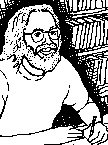
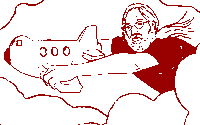
 |
Dolores Cacuango is a legendary hero of Ecuador's twentieth-century popular movements. She was an Indigenous leader, member of the Communist Party's Central Committee, and a strong feminist. She nicely represents in both symbolic and concrete terms the blending of race, class, and gender which typify my research. |
sabbatical | marc | mountains | masses | mujeres
Inspiring stories of resistance.
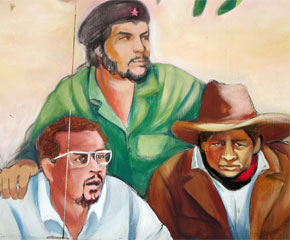 When a church has a mural that includes Che Guevara, Carlos Fonseca, and Augusto César Sandino, it is apparent that this is a special place. In the 1980s, the Batahola Community Center strongly supported the Sandinista revolution in Nicaragua and its murals champion their history of struggle. Neoliberal reforms in the 1990s, however, seemed to throw these advances back by 50 years. Armed struggle is now off the table, but we watched a dance betweeen social movements and electoral politics as popular movements fight to regain the initiative in this country.
When a church has a mural that includes Che Guevara, Carlos Fonseca, and Augusto César Sandino, it is apparent that this is a special place. In the 1980s, the Batahola Community Center strongly supported the Sandinista revolution in Nicaragua and its murals champion their history of struggle. Neoliberal reforms in the 1990s, however, seemed to throw these advances back by 50 years. Armed struggle is now off the table, but we watched a dance betweeen social movements and electoral politics as popular movements fight to regain the initiative in this country.
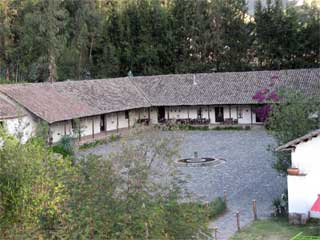 Now a hotel, the Guachalá Hacienda was once one of the largest and most famous rural estates in Ecuador. At its peak, it controlled most of the surrounding territory and operated very much as a world on to itself. In times past, owners meted out "hacienda justice" to their Indigenous workers in the hacienda patio. If peons demanded their rights, the owners would punish and even kill them. Today, the owner Diego Bonifaz is the mayor of Cayambe on the Indigenous-allied Pachakutik party. His cousin Cristóbal sued Texaco in New York for polluting Indigenous lands in the Ecuadorian Amazon. Cristóbal's sun John is author of Warrior King: The Case for Impeaching George Bush. Not only does Guachalá have a fascinating history, but its owners also make for an interesting family.
Now a hotel, the Guachalá Hacienda was once one of the largest and most famous rural estates in Ecuador. At its peak, it controlled most of the surrounding territory and operated very much as a world on to itself. In times past, owners meted out "hacienda justice" to their Indigenous workers in the hacienda patio. If peons demanded their rights, the owners would punish and even kill them. Today, the owner Diego Bonifaz is the mayor of Cayambe on the Indigenous-allied Pachakutik party. His cousin Cristóbal sued Texaco in New York for polluting Indigenous lands in the Ecuadorian Amazon. Cristóbal's sun John is author of Warrior King: The Case for Impeaching George Bush. Not only does Guachalá have a fascinating history, but its owners also make for an interesting family.
 Female genital mutilation creates many emotional and physical complications, including obstetric fistula. Delta Survie is an NGO in Mopti on the Niger River in Mali that works to improve the social and economic standing of women afflicted with fistula. They created a handcraft center that allowed women to earn money for their medical costs, food, and transportation home. The work is about more than generating an income. It helps the women not to think about their fistula. They are among others like themselves, which fosters a sense of acceptance.
Female genital mutilation creates many emotional and physical complications, including obstetric fistula. Delta Survie is an NGO in Mopti on the Niger River in Mali that works to improve the social and economic standing of women afflicted with fistula. They created a handcraft center that allowed women to earn money for their medical costs, food, and transportation home. The work is about more than generating an income. It helps the women not to think about their fistula. They are among others like themselves, which fosters a sense of acceptance.
 The Prescraft Center in Bali has its roots in a Presbyterian Church mission dating back over one hundred years. This is a large and well-run center, with many different projects. About sixty people work on craft and carpentry projects. There are also hundreds of children at the center studying in their school. Most children seem to love cameras, and inevitably will show off when one is present. The instant gratification of a seeing their image on the LCD panel of a digital camera dramatically increases this response. These children's energy and happiness gives us hope for the future.
The Prescraft Center in Bali has its roots in a Presbyterian Church mission dating back over one hundred years. This is a large and well-run center, with many different projects. About sixty people work on craft and carpentry projects. There are also hundreds of children at the center studying in their school. Most children seem to love cameras, and inevitably will show off when one is present. The instant gratification of a seeing their image on the LCD panel of a digital camera dramatically increases this response. These children's energy and happiness gives us hope for the future.
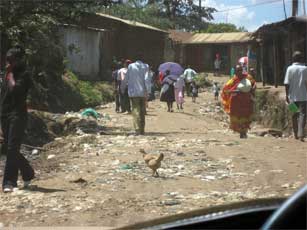 Kibera is Africa's largest slum. Located south-west of Nairobi, Kenysa, it is not the type of place an outsider would want to wonder into alone. Perhaps as many as a million people live in Kibera's vast expanse of mud-walled shacks and open sewers. We road in with an NGO who works with a school and other social projects in a compound that felt like an oasis in the middle of the slum. After the visit they asked if we wanted to walk around Kibera for a bit. They found a local kid who had attended the school and could provide us with a bit of security. We found a certain amount of hope and friendliness in the middle of the desperation.
Kibera is Africa's largest slum. Located south-west of Nairobi, Kenysa, it is not the type of place an outsider would want to wonder into alone. Perhaps as many as a million people live in Kibera's vast expanse of mud-walled shacks and open sewers. We road in with an NGO who works with a school and other social projects in a compound that felt like an oasis in the middle of the slum. After the visit they asked if we wanted to walk around Kibera for a bit. They found a local kid who had attended the school and could provide us with a bit of security. We found a certain amount of hope and friendliness in the middle of the desperation.
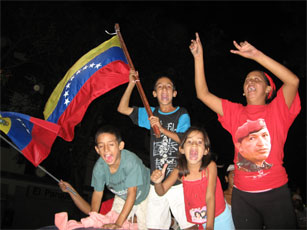 In Venezuela, we celebrated Hugo Chavez's reelection as president on December 3. When the electoral council made the announcement that he had won, the streets in Barquisimeto where we observed the elections came alive with his supporters. Chavez talks about leading Venezuela into a new model of twenty-first century socialism. For the first time in its history, the country's imense oil wealth is funding social programs that benefit the people rather than enriching a small elite and transnational corporations. The Bolivarian Revolution becomes a model that the rest of us admire and learn from in order to improve our own realities.
In Venezuela, we celebrated Hugo Chavez's reelection as president on December 3. When the electoral council made the announcement that he had won, the streets in Barquisimeto where we observed the elections came alive with his supporters. Chavez talks about leading Venezuela into a new model of twenty-first century socialism. For the first time in its history, the country's imense oil wealth is funding social programs that benefit the people rather than enriching a small elite and transnational corporations. The Bolivarian Revolution becomes a model that the rest of us admire and learn from in order to improve our own realities.
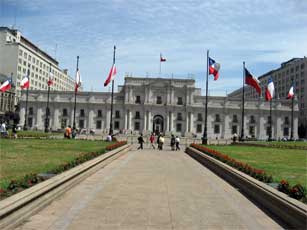 Palacio de la Moneda is where our dreams died. On September 11, 1973, Augusto Pinochet bombed the Chilean "White House," killing socialist president Salvador Allende. Allende was making great strides in redirected Chile's resources to benefit the Chilean people rather than multinational corporations. In response, the Nixon administration supported the brutal military coup rather than the democratically elected, constitutional government. A week before the coup, on the the third anniversary of Allende's election on September 4, 1970, one of the largest marches in Chile's history filed past la Moneda chanting "Allende, Allende, el pueblo te defende" (Allende, the people will defend you). Had Allende fallen back on that popular support as Chavez did in the failed April 2002 coup in Venezuela, he may have survived and the world may well be a very different (and better) place today.
Palacio de la Moneda is where our dreams died. On September 11, 1973, Augusto Pinochet bombed the Chilean "White House," killing socialist president Salvador Allende. Allende was making great strides in redirected Chile's resources to benefit the Chilean people rather than multinational corporations. In response, the Nixon administration supported the brutal military coup rather than the democratically elected, constitutional government. A week before the coup, on the the third anniversary of Allende's election on September 4, 1970, one of the largest marches in Chile's history filed past la Moneda chanting "Allende, Allende, el pueblo te defende" (Allende, the people will defend you). Had Allende fallen back on that popular support as Chavez did in the failed April 2002 coup in Venezuela, he may have survived and the world may well be a very different (and better) place today.
 Ducking quickly into Montevideo on a holiday weekend is not the best way to get a fill of politics and history, but on the walls there are markers of struggles. Across the street from our hotel the graffiti reads "we want housing" and loudly demands justice. Other graffiti demands a halt to free trade agreements (TLC, for Tratados de Libre Comercio in Spanish). Uruguay has made progress under Tabaré Vázquez, but not as quickly as some might desire. We visit a street market that is filled with books, both new and used. Although Uruguay is one of the least studied of the Latin American republics, these writings point to a long and important history of struggle. I pick up a couple of Socialist Party pamphlets from the 1950s on national problems including agrarian reform, labor legislation, and educational policies.
Ducking quickly into Montevideo on a holiday weekend is not the best way to get a fill of politics and history, but on the walls there are markers of struggles. Across the street from our hotel the graffiti reads "we want housing" and loudly demands justice. Other graffiti demands a halt to free trade agreements (TLC, for Tratados de Libre Comercio in Spanish). Uruguay has made progress under Tabaré Vázquez, but not as quickly as some might desire. We visit a street market that is filled with books, both new and used. Although Uruguay is one of the least studied of the Latin American republics, these writings point to a long and important history of struggle. I pick up a couple of Socialist Party pamphlets from the 1950s on national problems including agrarian reform, labor legislation, and educational policies.
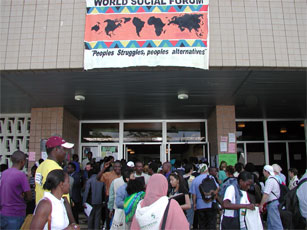 I write a lot more about this year's World Social Forum in Nairobi, and social forums in general, on my trip reports page. After a good run of seven years, attendance and energy at this year's forum tapered off. Formal records indicate that 46 thousand delegates registered for the forum, mostly from outside of Kenya. In previous forums, local attendees had overwhelmingly defined the face and composition of the forum. The 500 KSH entrance fee (almost $10 USD) kept most Kenyans out. Protests, however, led to an opening of the gates and in the end who knows how many attended the forum. The forum turned into a bit of a market atmosphere, with vendors flooding onto the grounds to hawk their wares. The forum closed with an energetic assembly of social movements with a broad range of organizations presenting ideas and plans on how to make a new and better world.
I write a lot more about this year's World Social Forum in Nairobi, and social forums in general, on my trip reports page. After a good run of seven years, attendance and energy at this year's forum tapered off. Formal records indicate that 46 thousand delegates registered for the forum, mostly from outside of Kenya. In previous forums, local attendees had overwhelmingly defined the face and composition of the forum. The 500 KSH entrance fee (almost $10 USD) kept most Kenyans out. Protests, however, led to an opening of the gates and in the end who knows how many attended the forum. The forum turned into a bit of a market atmosphere, with vendors flooding onto the grounds to hawk their wares. The forum closed with an energetic assembly of social movements with a broad range of organizations presenting ideas and plans on how to make a new and better world.
 Amsterdam might be an unusual place to see a museum exhibit on Che, but that is where we are and that is the exhibit at the Tropenmuseum. The museum focuses on the tropics, and in particular how it relates to The Netherlands. So, for example, the exhibit on Latin America and the Caribbean largely features the cultures of the former Dutch colonies Suriname and Curaçao. It provides a rather unique perspective on Latin America. The exhibit "Che! A commercial revolution" plays off of Alberto Korda's famous photo that has subsequently been extensively comercialized. The exhibit has little on The Netherlands, but perhaps its mere existance says something about the Dutch. If anyone is curious, no, the edition of Che's Guerrilla Warfare for which I wrote the introduction did not make it into the exhibit.
Amsterdam might be an unusual place to see a museum exhibit on Che, but that is where we are and that is the exhibit at the Tropenmuseum. The museum focuses on the tropics, and in particular how it relates to The Netherlands. So, for example, the exhibit on Latin America and the Caribbean largely features the cultures of the former Dutch colonies Suriname and Curaçao. It provides a rather unique perspective on Latin America. The exhibit "Che! A commercial revolution" plays off of Alberto Korda's famous photo that has subsequently been extensively comercialized. The exhibit has little on The Netherlands, but perhaps its mere existance says something about the Dutch. If anyone is curious, no, the edition of Che's Guerrilla Warfare for which I wrote the introduction did not make it into the exhibit.
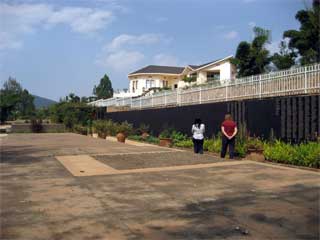 For many people, Rwanda seems to be synonymous with the 1994 genocide.I was surprised at how little of that history I saw marked on the country. The genocide was a Hutu-driven affair against the minority Tutsi population. I never once heard those terms used in the country, apparently as part of a conscious effort to grow beyond those ethnic divisions. The country is not very political. There is not a strong civil society, and an authoritarian culture remains in which people hesitate to take action unless ordered to do so. One place where this history is remembered is the Kigali Memorial Centre. An exhibit documents the genocide, and places it in a context of other 20th-century genocides. Bones and pictures are on display to assure that no one can every deny the horror of these events. Outside the building, ten mass graves hold more than 200,000 victims of the genocide--many of them never identified. The graves contrast markedly with tranquil gardens. The message from Rwanda seems to be that we are all capable of genocide. I leave the country trying to make sense of this history.
For many people, Rwanda seems to be synonymous with the 1994 genocide.I was surprised at how little of that history I saw marked on the country. The genocide was a Hutu-driven affair against the minority Tutsi population. I never once heard those terms used in the country, apparently as part of a conscious effort to grow beyond those ethnic divisions. The country is not very political. There is not a strong civil society, and an authoritarian culture remains in which people hesitate to take action unless ordered to do so. One place where this history is remembered is the Kigali Memorial Centre. An exhibit documents the genocide, and places it in a context of other 20th-century genocides. Bones and pictures are on display to assure that no one can every deny the horror of these events. Outside the building, ten mass graves hold more than 200,000 victims of the genocide--many of them never identified. The graves contrast markedly with tranquil gardens. The message from Rwanda seems to be that we are all capable of genocide. I leave the country trying to make sense of this history.
 Once we arrive in Manta, we have a half-day conference and then a late afternoon march to the Eloy Alfaro Air Base where the United States has troops stationed as part of its Forward Operating Location (FOL). President Jamil Mahuad signed a 10-year lease agreement in 1999, a decision that has proved to be unpopular and some argue unconstitutional. The purported purpose of the FOL was to help interdict drug shipments from neighboring Colombia, but opponents contend that the U.S. government has exploited the opening to move well beyond that mandate into counter-insurgency and anti-immigrant activities. Current president Rafael Correa has quipped that it is ok with him if the U.S. maintains the base at Manta if Ecuador is allowed to set up a base in Miami. It helps put the issue in context. Correa says that he will not renew the lease agreement when it expires in 2009. We march to the gates of the base where we chant as a line of police, then a line of barbed wire and tank traps, and a line of heavily armed soldiers guard the base from unarmed protesters.
Once we arrive in Manta, we have a half-day conference and then a late afternoon march to the Eloy Alfaro Air Base where the United States has troops stationed as part of its Forward Operating Location (FOL). President Jamil Mahuad signed a 10-year lease agreement in 1999, a decision that has proved to be unpopular and some argue unconstitutional. The purported purpose of the FOL was to help interdict drug shipments from neighboring Colombia, but opponents contend that the U.S. government has exploited the opening to move well beyond that mandate into counter-insurgency and anti-immigrant activities. Current president Rafael Correa has quipped that it is ok with him if the U.S. maintains the base at Manta if Ecuador is allowed to set up a base in Miami. It helps put the issue in context. Correa says that he will not renew the lease agreement when it expires in 2009. We march to the gates of the base where we chant as a line of police, then a line of barbed wire and tank traps, and a line of heavily armed soldiers guard the base from unarmed protesters.
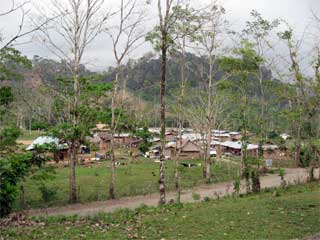 Ten years ago in the midst of Colombia's ongoing violent conflict, San José de Apartadó labeled itself a peace community. They declared the town offlimits to all armed actors--the police, military, paramilitary, and guerrillas. Two years ago, leader Luis Eduardo Guerra was killed in a massacre in which military officials were implicated. In response, the police and military descended on the town. When they refused to leave, community members retreated down the road and set up a new community they named San Josecito. All government officials we met refused to call the settlement San Josecito, but rather referred to it as La Holandita, the previous name of the farmland on which they had settled. When David challenged Defense Viceminister Sergio Jaramillo why he did not use San Josecito, he claimed that he had never heard it referred to as such before. In the face of official opposition and overwhelming odds, the people of San Josecito hold on as they try to rebuild their lives.
Ten years ago in the midst of Colombia's ongoing violent conflict, San José de Apartadó labeled itself a peace community. They declared the town offlimits to all armed actors--the police, military, paramilitary, and guerrillas. Two years ago, leader Luis Eduardo Guerra was killed in a massacre in which military officials were implicated. In response, the police and military descended on the town. When they refused to leave, community members retreated down the road and set up a new community they named San Josecito. All government officials we met refused to call the settlement San Josecito, but rather referred to it as La Holandita, the previous name of the farmland on which they had settled. When David challenged Defense Viceminister Sergio Jaramillo why he did not use San Josecito, he claimed that he had never heard it referred to as such before. In the face of official opposition and overwhelming odds, the people of San Josecito hold on as they try to rebuild their lives.
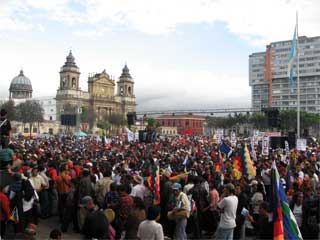 The slogan “from resistance to power” captured the spirit of the Indigenous summit. It is not enough to resist oppression, but Indigenous peoples need to forward concrete and positive alternatives to make a better and more inclusive world. Participants engaged in a panels on nation states, territory, and Indigenous governments, and in working groups on self-determination, plurinationality, intellectual property rights, identity and cosmology, women, children, globalization, communication, and Indigenous justice systems. In the Declaration of Iximché, delegates ratified their ancestral right to territory and common resources of the mother earth, rejected free trade pacts, condemned the construction of a wall between Mexico and the United States, and called for the legalization of coca leaves. The summit culminated with a massive march on Guatemala City's main square. The energy level throughout the event was good, and the closing rally made sure the event ended on a high note.
The slogan “from resistance to power” captured the spirit of the Indigenous summit. It is not enough to resist oppression, but Indigenous peoples need to forward concrete and positive alternatives to make a better and more inclusive world. Participants engaged in a panels on nation states, territory, and Indigenous governments, and in working groups on self-determination, plurinationality, intellectual property rights, identity and cosmology, women, children, globalization, communication, and Indigenous justice systems. In the Declaration of Iximché, delegates ratified their ancestral right to territory and common resources of the mother earth, rejected free trade pacts, condemned the construction of a wall between Mexico and the United States, and called for the legalization of coca leaves. The summit culminated with a massive march on Guatemala City's main square. The energy level throughout the event was good, and the closing rally made sure the event ended on a high note.
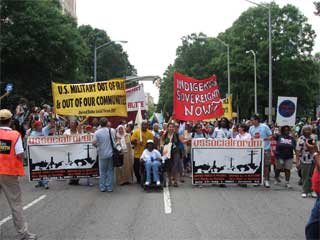 Social Forums often open with a march through the streets of the host city, and the United States Social Forum in Atlanta was no exception. On a hot and humid day, perhaps 10,000 people gathered at the Georgia State Capitol building. Two USSF banners and banners calling for “Indigenous Sovereignty Now” and “U.S. military out of Iraq & out of our communities” led the march from the Georgia State Capitol to the Atlantic Civic Center that provided the home base for the forum. As with other social forum marches, placards advocated for the broad range of issues that make up social movements–environmental, homeless, immigrant, women’s, and many other issues. Numerous banners called for the impeachment of Bush and Cheney for war crimes. Theater is always a part of these marches, with puppets and others on stilts adding color and excitement to the event.The USSF built on the two main issues that drives the WSF: opposition to corporate globalization and repressive neo-liberal policies that leave deep marks on marginalized communities.
Social Forums often open with a march through the streets of the host city, and the United States Social Forum in Atlanta was no exception. On a hot and humid day, perhaps 10,000 people gathered at the Georgia State Capitol building. Two USSF banners and banners calling for “Indigenous Sovereignty Now” and “U.S. military out of Iraq & out of our communities” led the march from the Georgia State Capitol to the Atlantic Civic Center that provided the home base for the forum. As with other social forum marches, placards advocated for the broad range of issues that make up social movements–environmental, homeless, immigrant, women’s, and many other issues. Numerous banners called for the impeachment of Bush and Cheney for war crimes. Theater is always a part of these marches, with puppets and others on stilts adding color and excitement to the event.The USSF built on the two main issues that drives the WSF: opposition to corporate globalization and repressive neo-liberal policies that leave deep marks on marginalized communities.
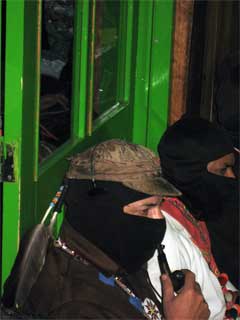 After seeing Fidel Castro, Hugo Chavez, and Evo Morales, Subcomandante Marcos was the last major living revolutionary leader whom I had wanted to see in action. I finally had my chance at a roundtable on the defense of land and territory leading up to the Encuentro Zapatista in Chiapas. While waiting for the roundtable to begin, we saw a line of masked Zapatistas walk from a neighboring building to the chapel where the roundtable took place. I should have run over then to snap a closer picture. But then word went around that Marcos was sitting by the back door and one could stick a camera in and snap a picture. So I joined the paparazzi to get my picture. What a surprise to see Marcos with a bit of a paunch. I guess he is not running around in the jungle anymore. For other speakers, I left my seat on a bench outside the chapel (since it was full inside) to stick my camera through a window to take pictures. Marcos was the last speaker, and I was left with a choice: move to the loudspeaker in an attempt to get a higher quality recording for my community radio station WORT to use on En Nuestro Patio, or leave the I-River and try to squeeze into the increasingly occupied window spaces to get yet another blurry photo of the Sup. I deeply regretted not arriving early enough to get a seat in the church, or to squeeze in as Gwen had done to be able to observe the spectacle in person. In the end, I opted for a clear recording. So I heard, but did not see. Mission half accomplished?
After seeing Fidel Castro, Hugo Chavez, and Evo Morales, Subcomandante Marcos was the last major living revolutionary leader whom I had wanted to see in action. I finally had my chance at a roundtable on the defense of land and territory leading up to the Encuentro Zapatista in Chiapas. While waiting for the roundtable to begin, we saw a line of masked Zapatistas walk from a neighboring building to the chapel where the roundtable took place. I should have run over then to snap a closer picture. But then word went around that Marcos was sitting by the back door and one could stick a camera in and snap a picture. So I joined the paparazzi to get my picture. What a surprise to see Marcos with a bit of a paunch. I guess he is not running around in the jungle anymore. For other speakers, I left my seat on a bench outside the chapel (since it was full inside) to stick my camera through a window to take pictures. Marcos was the last speaker, and I was left with a choice: move to the loudspeaker in an attempt to get a higher quality recording for my community radio station WORT to use on En Nuestro Patio, or leave the I-River and try to squeeze into the increasingly occupied window spaces to get yet another blurry photo of the Sup. I deeply regretted not arriving early enough to get a seat in the church, or to squeeze in as Gwen had done to be able to observe the spectacle in person. In the end, I opted for a clear recording. So I heard, but did not see. Mission half accomplished?